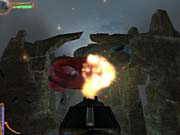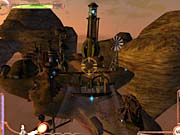CDV's colorful hybrid game Project Nomads features elements from some of the most unique PC games ever produced. It has the backpack-jumping action of Giants: Citizen Kabuto, the third-person real-time strategy-style base building of Sacrifice and Battlezone, and, perhaps strangest of all, the islands-in-the-sky fortresses of the obscure 1997 game NetStorm: Islands at War. But the pieces fit together in a puzzling manner. Though Project Nomads draws inspiration from some truly original games, the game itself ends up being a fairly generic shooter. Once you get past the quirky decor, you'll find a game that's more akin to Incoming (or its recent sequel, Incoming Forces). In the game, you spend the majority of your time manning turrets and gunning down enemy buildings and units, occasionally jumping into aircraft or running around on foot to the same destructive end.

Project Nomads is set in a strange world of floating islands and evil insects. You choose one of three characters--John, Susie, or Goliath--and then set out to find the other two, who are captured during the game's opening sequence. At the outset, you will be given an island that will serve as your base. As the game progresses, you'll collect artifacts that let you construct buildings on your island. There are buildings that generate energy (the game's only resource), hangars that produce bombers and fighters, and turrets that defend you from enemy units. The buildings look distinct for each character, but otherwise the game plays similarly no matter whom you choose. The game's unusual visual design is accompanied by a disjointed and nearly nonsensical fantasy story--the kind in which strange names, titles, and places are referred to commonly, but never really explained. Not that it matters much. By the time you're told to go to the second level to find the "master builder," you'll know that it just means you need to go shoot a bunch of stuff.
Project Nomads' real-time strategy elements are limited to building on your island. You don't have much room, but there isn't much in the way of strategy in determining where to put what. Resource collection is likewise not too much of a problem, and once you set up your main power generator, you won't have to think about it too much. If Project Nomads required a bit more strategic planning, it probably would have been much more interesting.
The game's action elements are better. Many of your guns will work automatically, and most will be better at shooting down the enemy than you will. You get cannons and guided missiles you can control yourself, and these will be employed to shoot down wave after wave of enemies and destroy their bases once their offensive units are incapacitated.
You also have access to fighters and bombers, and these also operate automatically. Or, you can jump in the cockpit and control them yourself. The latter is often a good plan because the artificial intelligence for the aircraft is unreliable at best. For instance, enemy aircraft will often fly right into mountains. You'll see a very clear example of this in one of the few missions that doesn't require you to just shoot and shoot and shoot some more--a mission in which you must pose as an enemy pilot and follow enemy aircraft in formation. The holes in the aircraft AI are all too apparent in this mission, since other aircraft can and do fly right into you with no concern for anyone's well-being.
But at least this mission tries something different. Most of Project Nomads' other missions are just exercises in repetition. You generally play most of the game on your island, shooting at stuff on foot or in turrets, or shooting at stuff using magic spells. Unfortunately, not even magic is interesting in Project Nomads. Each character has a "battle spell," which is just a generic projectile. The enemies you shoot are big insects (almost all of which are identical), and they leave behind a poison gas that will damage you if you touch it. So the on-foot missions generally boil down to shooting, waiting, or moving, interrupted by the occasional jump over a small chasm.

These flaws are unfortunate, because Project Nomads contains bits of real inspiration. Its various elements almost seem to hint at a better game, as if the designers conceived of a great setting and premise but couldn't figure out what to do with them afterward. The game's buildings and island fortresses look good, and some of the aircraft designs are really inventive. The characters are well designed--most notably the leader of the sentinels, who wouldn't look out of place in one of Shiny's typically bizarre-looking games. Unfortunately, the characters' voices seem like placeholder material, and they don't often match the appearances and personalities of the characters themselves. Luckily, Project Nomads' music is subtle but appropriate, with nice dramatic drum pounding when the action gets warm.
And though the action does get warm, it never heats up. Even as a generic action game, Project Nomads is never very exciting. Your automatic weapons can handle most of what's thrown at you, the enemies aren't very smart, and the missions are so repetitive that there are hardly any surprises. It's relatively fun in small doses, but Project Nomads doesn't live up to the potential that its unusual design suggests.